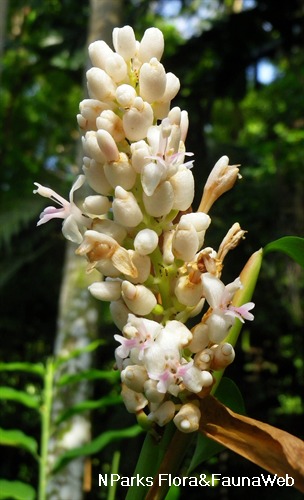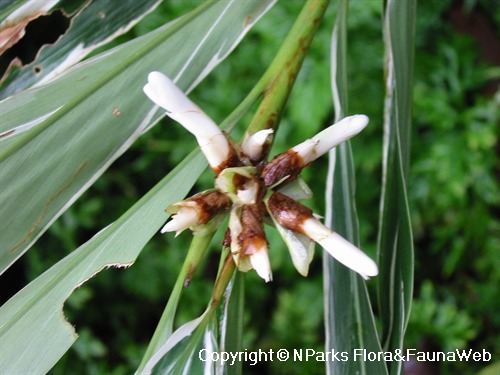.jpg)
Back
Alpinia mutica Roxb.
| Family Name: | Zingiberaceae |
| Synonyms: | Catimbium muticum (Roxb.) Holttum, Languas mutica (Roxb.) Merr., Renealmia mutica (Roxb.) Salisb., Alpinia korthalsii K. Schum., Alpinia laxiflora Gagnep., Alpinia mutica var. laxiflora (Gagnep.) Gagnep., Languas korthalsii (K.Schum.) Merr., Languas laxiflora (Gagnep.) Merr. |
| Common Name: | Orchid Ginger, Small Shell Ginger, False Cardamom |
The Orchid Ginger is a popular ginger plant for landscaping in Singapore. It has lovely orchid-like flowers that are white with a deep yellow lip decorated with dark red lines and spots, its round fruit are an attractive orange-red colour. When crushed, its lance-shaped foliage releases a spicy aroma similar to that of cinnamon and citrus. It grows well in Singapore under semi-shade and in moist soil.
Name
Classifications and Characteristics
| Plant Division | Angiosperms (Flowering Seed Plants) |
|---|---|
| Plant Growth Form | Herbaceous Plant |
| Lifespan (in Singapore) | Perennial |
| Mode of Nutrition | Autotrophic |
| Maximum Height | 1 m to 2 m |
Biogeography
| Native Habitat | Terrestrial |
|---|---|
| Preferred Climate Zone | Tropical |
| Local Conservation Status | Non-native (Spontaneous (Casual)) |
Description and Ethnobotany
| Growth Form | Herbaceous plant forming dense clumps up to 2 m tall. |
|---|---|
| Foliage | The linear to lance-shaped leaves (40-60 cm long, 10-13 cm wide) are arranged in 2 files along the stem. Crushed leaves produce a spicy fragrance similar to that of cinnamon and citrus. |
| Stems | It produces an underground horizontal stem, known as a rhizome. |
| Flowers | The flowers are arranged in a terminal inflorescence known as a cyme. The shell-shaped, white flower (5.5-5.7 cm long) hangs down from a green stalk and has an ornamental yellow lip with red dots and lines, lasting about one day. In Singapore, this plant regularly flowers. |
| Fruit | The ball-shaped, fleshy fruit is known as a capsule (~3 cm wide) and matures from green to orange or red. It contains many black, angled seeds (6-7 mm long). The seeds may germinate while still attached to the parent plant. |
| Habitat | It naturally occurs in swampy areas. |
| Associated Fauna | The flowers are pollinated by Carpenter Bees (Xylocopa spp.) and Blue-banded Bees (Amegilla spp.). |
| Cultivation | It grows best in rich, organic soil kept moist and tolerates waterlogged soils. Young plants need semi-shade or filtered light, while established plants can tolerate full sun in a humid climate. Cut down old stems once or twice a year. Sometimes, it is attacked by mealy bugs. |
| Ethnobotanical Uses | Edible Plant Parts : Edible Stems Medicinal: In Peninsular Malaysia, an infusion of the rhizome (the underground horizontal stem) is taken to treat digestion problems and the fruit is used to reduce inflammation. This use is supported by research that found the rhizome to be rich in anti-fungal and anti-bacterial compounds, as well as antioxidants. |
Landscaping Features
| Desirable Plant Features | Ornamental Flowers, Fragrant (Foliage) |
|---|---|
| Landscape Uses | Parks & Gardens, Hedge / Screening |
| Thematic Landscaping | Marsh Garden |
Fauna, Pollination and Dispersal
| Fauna Pollination Dispersal Associated Fauna | Bee-Attracting |
|---|---|
| Pollination Method(s) |
Plant Care and Propagation
| Light Preference | Semi-Shade |
|---|---|
| Water Preference | Moderate Water |
| Plant Growth Rate | Fast |
| Rootzone Tolerance | Well-Drained Soils, Moist Soils, Fertile Loamy Soils |
| Propagation Method | Seed, Division |
Foliar
| Foliage Retention | Evergreen |
|---|---|
| Mature Foliage Colour(s) | Green |
| Mature Foliage Texture(s) | Leathery, Glossy / Shiny |
| Foliar Type | Simple / Unifoliate |
| Foliar Arrangement Along Stem | Alternate |
| Foliar Attachment to Stem | Petiolate |
| Foliar Shape(s) | Non-Palm Foliage (Lanceolate, Linear) |
| Foliar Venation | Pinnate / Net |
| Foliar Margin | Entire - Wavy / Undulate |
| Foliar Apex - Tip | Acuminate |
| Foliar Base | Acute, Clasping |
| Typical Foliar Area | Macrophyll ( 182.25cm2 - 1640.25 cm2 ) |
| Typical Foliar Size | 40 cm to 60 cm |
Floral (Angiosperm)
| Flower & Plant Sexuality | Bisexual Flowers |
| Flower Colour(s) | White, Yellow / Golden, Red |
|---|---|
| Flower Grouping | Cluster / Inflorescence |
| Flower Location | Terminal |
| Flower Symmetry | Bilateral |
| Individual Flower Shape | Labiate / Lipped |
| Flower Size | 5.6 cm |
Fruit, Seed and Spore
| Mature Fruit Colour(s) | Red, Orange |
|---|---|
| Mature Fruit Texture(s) | Velvety / Furry / Tomentose |
| Fruit Classification | Simple Fruit |
| Fruit Type | |
| Mature Seed Colour(s) | Black |
Image Repository
Others
| Master ID | 33794 |
|---|---|
| Species ID | 8210 |
| Flora Disclaimer | The information in this website has been compiled from reliable sources, such as reference works on medicinal plants. It is not a substitute for medical advice or treatment and NParks does not purport to provide any medical advice. Readers should always consult his/her physician before using or consuming a plant for medicinal purposes. |



.jpg)








